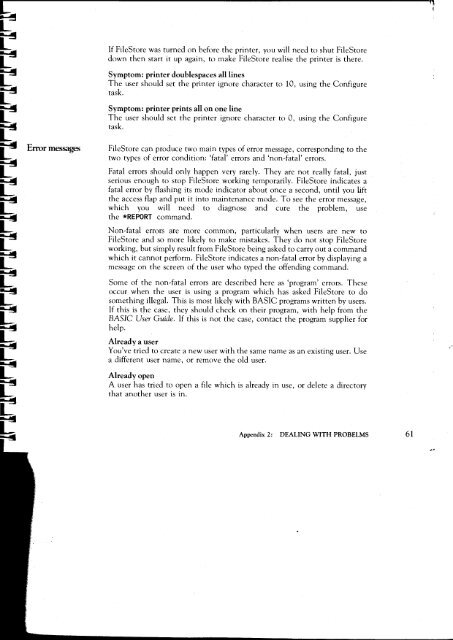Acorn Communicator Filestore Manager's Guide
Acorn Communicator Filestore Manager's Guide
Acorn Communicator Filestore Manager's Guide
You also want an ePaper? Increase the reach of your titles
YUMPU automatically turns print PDFs into web optimized ePapers that Google loves.
If FileStore was turned on before the printer, you will need to shut FileStore<br />
down then start it up again, to make FileStore realise the printer is there.<br />
Symptom: printer doublespaces all lines<br />
The user should set the printer ignore character to 10, using the Configure<br />
task.<br />
Symptom: printer prints all on one line<br />
The user should set the printer ignore character to 0, using the Configure<br />
task.<br />
Error messages FileStore can produce two main types of error message, corresponding to the<br />
two types of error condition: 'fatal' errors and 'non-fatal' errors.<br />
Fatal errors should only happen very rarely. They are not really fatal, just<br />
serious enough to stop FileStore working temporarily. FileStore indicates a<br />
fatal error by flashing its mode indicator about once a second, until you lift<br />
the access flap and put it into maintenance mode. To see the error message,<br />
which you will need to diagnose and cure the problem, use<br />
the *REPORT command.<br />
Non-fatal errors are more common, particularly when users are new to<br />
FileStore and so more likely to make mistakes. They do not stop FileStore<br />
working, but simply result from FileStore being asked to carry out a command<br />
which it cannot perform. FileStore indicates a non-fatal error by displaying a<br />
message on the screen of the user who typed the offending command.<br />
Some of the non-fatal errors are described here as 'program' errors. These<br />
occur when the user is using a program which has asked FileStore to do<br />
something illegal. This is most likely with BASIC programs written by users.<br />
If this is the case, they should check on their program, with help from the<br />
BASIC User <strong>Guide</strong>. If this is not the case, contact the program supplier for<br />
help.<br />
Already a user<br />
You've tried to create a new user with the same name as an existing user. Use<br />
a different user name, or remove the old user.<br />
Already open<br />
A user has tried to open a file which is already in use, or delete a directory<br />
that another user is in.<br />
Appendix 2: DEALING WITH PROBELMS 61
















